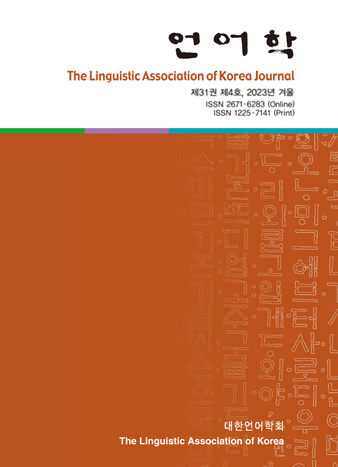대한언어학회 전자저널

31권 4호 (2023년 12월)
- 한국 수어의 시제와 상에 대한 언어유형론적 검토
-
정해권
Pages : 221-239
Abstract
Jeong, Haegwon. (2023). A linguistic typological view on tense and aspects of korean sign languages. The Linguistic Association of Korea Journal, 31(4), 221-239. Tense is a grammatical category that expresses the temporal position of an event, while aspect is a way to look into the internal temporal composition of an event. In the description of tense and aspect in Korean Sign Language, there is confusion in the use of terms and descriptions of grammar. Therefore, it is necessary that the onomasiological approach to tense and aspects in Korean Sign Language, that is a perspective to analyze from concepts to symbols used in Linguistic Typology. Inflectional elements that appear along the time line can be set as grammaticalized tense expressions in a sign language. The leaning forward is analyzed as the near future tense, and the slow leaning forward is the future in Korean Sign Language. There is neither a perfective aspect that expresses a global view of the event nor an imperfective, so such viewpoint aspects are not useful for distinguishing aspects in Korean Sign Language. On the other hand, from the perspective of phasal aspects, depending on the stages of progression of an event, there are prospective, inchoative, progressive, conclusive, completive, and resultative, which are also found in Korean Sign Language. In terms of tense and aspects in Korean Sign Language, it is analyzed that aspect is being grammaticalized into a more basic grammatical category, and tense is still in the early stages of grammaticalization. This is because the way of viewing temporal phases of events is more iconic and easier to recognize.
Keywords
# 오노마지올로지(onomasiology) # 미래 시제(future tense) # 예정상 (prospective) # 진행상(progressive) # 종결상(conclusive) # 완성상(completive) # 결과상(resultative)
References
- 김희섭. (1996). 한국 표준 수화의 자연언어성 고찰: 음운론을 중심으로. 언어과학, 3, 25-42.
- 목정수. (2016). 유형론과 정신역학론의 관점에서 본 한국어 서법과 양태. 한국어학, 70, 55-108.
- 박진호. (2011). 시제, 상, 양태. 국어학, 60, 289-322.
- 법제처. (2023). 한국수화언어법 [시행 2023. 8. 8.] [법률 제19592호, 타법개정].
- 서원희. (2020). 한국어와 한국수어의 상 대조 연구. 한국외국어대학교 석사학위논문.
- 석동일. (1990). 한국 수화의 언어학적 분석. 대구대학교 박사학위논문.
- 석수영. (2019). 수어. 임지룡 외(편). 인지언어학 탐구의 현황과 과제 (pp. 403-420). 서울: 한국문화사.
- 송미연. (2016). TV뉴스 한국수화언어 통역의 통사·의미론적 분석. 강남대학교 석사학위논문.
- 원성옥, 김유미, 남기현, 김성완. (2021). 한국수어 문법. 서울: 국립국어원.
- 윤병천, 김병하. (2004). 한국수화의 비수지신호에 대한 언어학적 특성 연구. 특수교육저널: 이론과 실천, 5(1), 253-277.
- 엄미숙. (1997). 한국수화의 통사론적 특징 분석. 대구대학교 석사학위논문.
- 이세은. (2015). 한국 수화의 상과 논항구조: 이동 동사를 중심으로. 고려대학교 석사학위논문.
- 이준우, 남기현. (2012). 한국 수어학 개론. 파주: 나남.
- 이현근. (2019). 명칭론(Onomasiology)과 어의론(Semasiology). 임지룡 외(편). 인지언어학 탐구의 현황과 과제 (pp. 699-721). 서울: 한국문화사.
- 임지룡. (2018). 한국어 의미론. 서울: 한국문화사.
- 정해권. (2019). 한국어 진행상과 결과상의 습득 연구 -‘-고 있-’과 ‘-어 있-’을 중심으로-. 새국어교육, 118, 257-280.
- 정해권. (2021). 한국어 문법상과 어휘상의 인지언어학적 접근. 담화와 인지, 28(3), 81-108. doi: 10.15718/discog.2021.28.3.81
- 최상배, 안성우. (2003). 한국수어의 이론. 서울: 서현사.
- 허용, 김선정. (2013). 대조언어학. 안양: 소통.
- Boneh, N., & Doron, E. (2010). Modal and temporal aspects of habituality. In M. R. Hovav, E. Doron, & I. Sichel (Eds.). Syntax, lexical semantics and event Structure (pp. 338-362). Oxford: Oxford University Press. DOI: https://doi.org/10.1093/acprof:oso/9780199544325.003.0016
- Bybee, J. L. (1985). Morphology: A study of the relation between meaning and form. Philadelphia: John Benjamins. 이성하·구현정 역. (2000). 형태론: 의미-형태의 관계에 대한 연구. 서울: 한국문화사.
- Bybee, J., Perkins, R., & Pagliuca, W. (1994). The evolution of grammar: tense, aspect, and modality in the languages of the world. Chicago: The University of Chicago Press. 박선자·김문기 역. (2010). 문법의 진화: 시제, 상, 양태. 서울: 소통.
- Comrie, B. (1976). Aspect. New York: Cambridge University Press.
- Dahl, Ö. (1985). Tense and aspect systems. New York: Blackwell.
- Dik, S. C. (1997). The theory of functional grammar: The structure of the clause. Berlin: Walter de Gruyter.
- Lakoff, G. (1993). The contemporary theory of metaphor. In A. Ortony (Ed.).
- Metaphor and Thought (2nd) (pp. 202-251). Cambridge: Cambridge University Press.
- Nedjalkov, V., & Jaxontov, S. (1988). The Typology of Resultative Constructions. In V.
- Nedjalkov (Ed.). Typology of Resultative Constructions (pp. 3-62). Amsterdam: John Benjamins Publishing.
- Pfau, R., Steinbach, M., & Woll, B. (2012). Sign Language: An International Handbook. Berlin: Mouton De Gruyter.
- Radden, G., & Dirven, R. (2007). Cognitive English Grammar. Amsterdam: John Benjamins Publishing Company.
- Smith, C. S. (1997). The parameter of aspect (2nd). Boston: Kluwer.
- Stokoe, W. C. (1972). Semiotics and Human Sign Languages. Hague: Walter de Gruyter.
- Sutton-Spence, R., & Woll, B. (1999). The Linguistics of British Sign Language: an Introduction. Cambridge: Cambridge University Press.
- Whaley, L. J. (1997). Introduction to Typology: The Unity and Diversity of Language, Thousand Oaks, CA: Sage Publishication. 김기혁 역. (2010). 언어 유형론: 언어의 통일성과 다양성. 서울: 소통.
- Zucchi, S. (2009). Along the Time Line: Tense and Time Adverbs in Italian Sign Language. Natural Language Semantics, 17, 99-139.